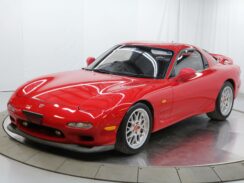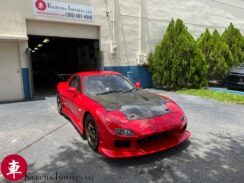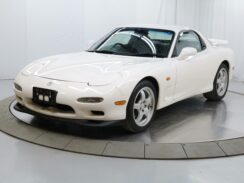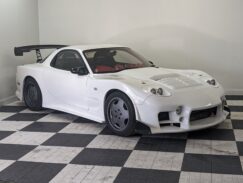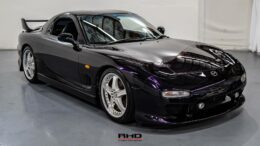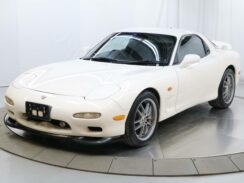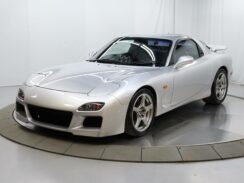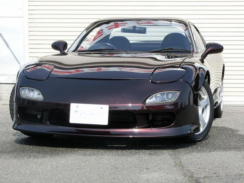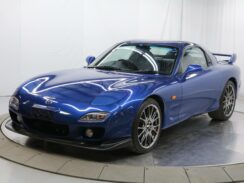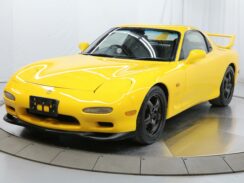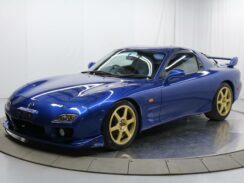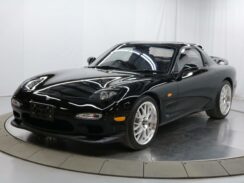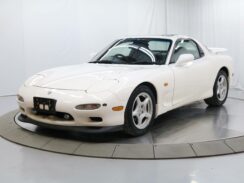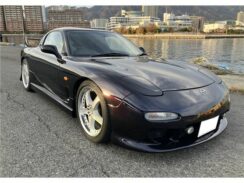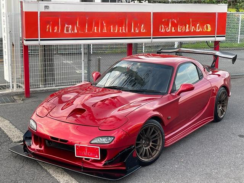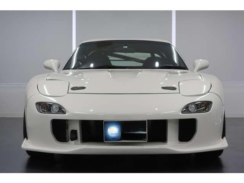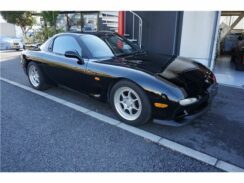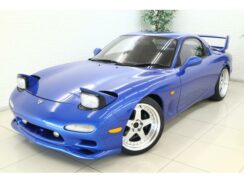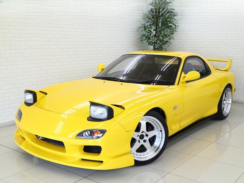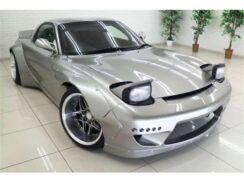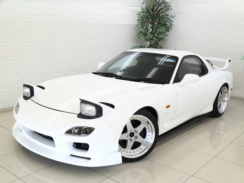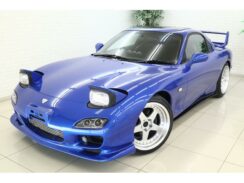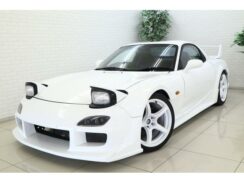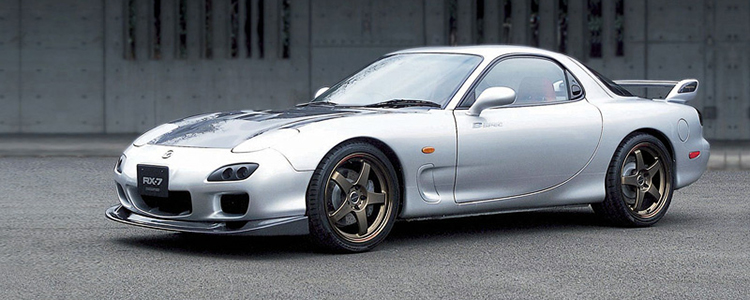Mazda RX-7 Spirit R Type B
Mazda RX-7 Type R Bassaist
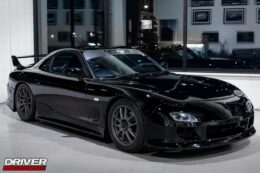
1995 Mazda RX7
Mazda RX-7 Type RB
Mazda RX-7 Type R
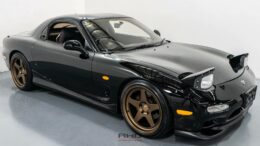
1994 Mazda RX7 FD (WA)

Mazda RX-7 Type RB Bassaast
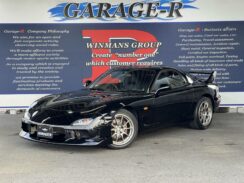
Mazda RX-7 Type RB Bassaast
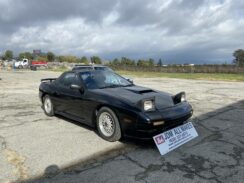
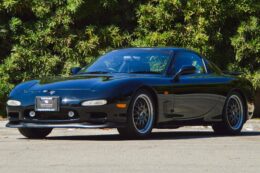
1995 Mazda FD RX7 RZ
1 - 36 of 53 Mazda RX-7 ads
Mazda RX-7 Buying Guide
The Mazda RX-7 was unlike any other sports car of its era due to its unique rotary Wankel engine. The rotary engine doesn’t have conventional pistons but rather has one large reciprocating piston that resembles a triangle. The result is a compact, simple, and light motor that has a higher power-to-weight ratio when compared to a normal internal combustion engine. This also means that the Wankel rotary engine can rev at much higher rpm.
Mazda built the RX-7 for nearly 25 years from 1978 to 2002 and spanned three generations. All RX-7s were built to be front mid-engine RWD sports cars with two seats, although there were a few 2+2 configurations.
Thanks to its unique look, engine, and exposure in movies, video games, and magazines, the RX-7 has reached legendary status amongst the JDM community. As these cars are very sought after, prices are steadily climbing, and finding a good, well-preserved example is becoming increasingly difficult.
We have created this in-depth buyer’s guide for those in the market for a new RX-7, or for someone who simply just wants to know more about this unique Japanese sports car. We condensed numerous hours of information into one intuitive and helpful buyer’s guide to help you better understand and know what to look for when buying your dream car.
Mazda RX-7 Pros and Cons
Pros
Highly Tunable Rotary Engines
Despite being labeled the most unreliable JDM tuner car next to Subarus, building and tuning a Mazda RX-7 is relatively easy. But it takes patience, deep pockets, and guts due to the risks involved and future problems. A single-rotor rotary engine only has two moving parts: the eccentric shaft (E-shaft), and a dual rotor has three as it has an additional rotor. Lesser moving parts contribute to a rotary engine’s lightweight nature, low vibration, and high revving capabilities, and it is easier to build since it requires lesser parts.
Most tuners will not recommend it, but 400-500 horsepower is easily achievable from a twin-turbo 13B with stock internals and minimal bolt-on mods such as an upgraded fuel system and turbos which is a moderate increase from the factory 300-ish horsepower. Naturally aspirated 13Bs and 12As can’t get to those numbers, but 250 horsepower is decent for a daily driver car without risking catastrophic engine failure.
Going all out on a Mazda RX-7 means using forged internals and aftermarket peripherals to rebuild, which might get the engine close to or slightly over 1000 horsepower, depending on how good the parts are and the tuner. If that isn’t enough, why not build a four-rotor screamer RX-7? It might sound crazy, but it has been done before, and it’s very much possible due to the rotary engine’s compact size and lesser moving parts.
Reasonably Priced
The Mazda RX-7 cannot be described as a cheap or affordable JDM car, but it’s the only reasonably priced iconic JDM car. Prices start at approximately $50,000, about half as much as a Nissan Skyline R34 GT-R or a Honda NSX is worth today. But we all know prices will increase, especially with JDM car prices at an all-time high due to increasing demand and rarity, among other factors, which is one of the reasons you should get one. Older RX-7 generations aren’t as pricey as the FD RX-7, and these rarely appreciate. It’s possible to get one for under $20,000, and you won’t have to spend much to build it to meet or exceed RX-7 FD specifications.
Aesthetically Pleasing

The Mazda RX-7 isn’t a crown puller like other JDM cars, such as the Toyota Supra and Nissan Skyline, but it will sure turn a few heads and strike smiles and awes on the street. Most enthusiasts love it for its unique rotary engine, which is one of the best-sounding engines. Still, only a few take a moment to appreciate how beautiful it is, especially in the Sunburst Yellow factory colour. What makes the Mazda RX-7 unique is that it still had pop-up headlights, carried from the first-gen RX-7 SA in the 1990s, and most cars didn’t due to traffic laws that banned them. Nobody knows how Mazda got around it, but as car enthusiasts, we are glad they did.
Other finer details that make the RX-7 FD stand out are the eye-shaped daytime running lights, the taillight across the rear, and the wing that perfectly complements the curved rear end. The door handles are embedded into the door giving the side profile a smooth, clean look, but first-timers need help locating them. Older RX-7s look great too, and one can’t fail to notice how Mazda kept the design language constant in every generation. The Mazda RX-7 is a car that will remain one of the best looking in the JDM cars’ Hall of Fame.
Tons of Fun to Drive
For a JDM car lover, there’s nothing remotely close to driving a JDM car from the 1990s, and it doesn’t matter whether it’s modified or stock. The Mazda RX-7 is one of those cars, and if driving one wouldn’t make you change your thoughts on how unreliable people say it is, then it’s not the car for you. Slamming the pedal to the metal and listening to the screaming exhaust is satisfying, and RX-7 owners will tell you that’s one of the best highlights of owning a car with a rotary engine.
Throttle response is smooth, and you’ll enjoy exhaust notes through the RPM range, which redlines at 9000 revs! One might doubt the handling of a Mazda RX-7, but the double wishbone suspension, low ride height, and lightweight chassis make it an easy-driving car even at high speeds. Get one with a Torsen LSD, and you’ll be fighting the urge to drift around every corner you take. It’s more fun driving an RX-7 with a 5-speed manual transmission than one with a 4-speed automatic or 3-speed automatic in the first generation. The only downside, if you are in the market for one, is that no RX-7s were manufactured with a 6-speed manual transmission.
Vast Aftermarket Support
Cosmetic parts such as body kits, wheels, turbochargers, aftermarket bucket seats, and anything else you might need to build your RX-7 are readily available thanks to aftermarket and custom parts manufacturers. This is enabled by the RX-7’s popularity on United States roads and being among the most iconic JDM cars. Some parts, such as the VeilSide body kit on Han’s RX-7 from the Fast and Furious Tokyo drift, might take a while to lay your hands on them. Waiting time aside, at least they still make it more than 15 years since it first debuted in 2005.
RX-7 owners also have communities and forums like other JDM car owners from which you can get tons of helpful information, especially if you are a first-time owner. Rotary engines require gifted hands to work on, but YouTube videos and repair guides online might help you gain momentum if you can do it.
Cons
There’s a Chance You Might Buy a Lemon
Owning an RX-7 can be frustrating mainly because of high maintenance costs and engine-related issues, and some owners continue driving the cars even after such issues occur. When they’re fed up with the car, they clean it up nicely and fix some issues that might be noticeable before listing it for sale with “minor” or no issues. Most novice buyers will buy the car without detecting any issues, and they’ll end up hating RX-7s and any other Mazda with a rotary engine for the rest of their lives.
Not so Accommodating Interior
The Mazda RX-7 might be a four-seater with a 2+2 seat setup, but the cabin is so cramped up that removing the rear seats is one of the first “mods” owners do. A 12-year-old kid would have difficulties being comfortable. Mazda even produced some units with only the front seats, which aren’t that comfortable, especially for big-bodied or tall drivers. The only form of creature comfort you’ll get in an RX-7 is the air conditioning. Most don’t have cup holders, and the glove compartment is too small, but you can’t do much because it Is a race car.
Requires Deep Pockets to Run And Maintain
Any car with a rotary engine requires high maintenance, and the Mazda RX-7 is no exception. An engine oil change is required every 1000 or 2000 miles, depending on the mods done, and it must be high-quality fuel if you want the engine to last. Fueling becomes an issue since rotary engines chug fuel like oil. Regular maintenance checks are required, which also are costly. All these costs make the Mazda RX-7 unsuitable for a first-time JDM car buyer.
Mazda RX-7 Common Issues
Damaged Apex Seals
One of the biggest engine-related issues in the Mazda RX-7, or any Mazda with a rotary engine, is apex seal failure. But before we dig deeper into possible causes and how to fix the apex seals, what are they? Rotary engines don’t have pistons like regular piston engines. They have triangular-like rotors, nicknamed Doritos, that serve the same purpose as the pistons. The rotor is enclosed in a housing leaving three chambers where air and fuel are first injected, compressed, and ignited as the rotor rotates on the eccentric drive shaft. The combustion occurs after ignition and exhaust gases exit the housing via an exhaust port.
For each apex (corner of a triangle) on the rotor, there’s a seal that keeps the corresponding chamber airtight, and each apex seal is loaded with a flat spring to maintain contact with the housing. Apex seals and springs are expected to wear out after around 100,000 miles or less, but there are other causes of apex seal failure. The first is insufficient lubrication since they have to be constantly covered in engine oil injected through an injector hole in the housing to reduce friction as the rotor rotates in the combustion chamber. That is one of the reasons rotary engines have slightly higher oil consumption by design.
Another reason apex seals fail is poor combustion caused by poor combustion as the pressure generated after combustion also helps keep the seals in place. If premature detonation or incomplete combustion occurs, it might cause pressure loss in one or two chambers when the seals break off. Also, rotary engines expect normal wear and tear, especially on the apex seals, side seals, and face seals.
When the apex seals break, they fall off the rotor and get ground against the rotor housing, causing what is known as the devil’s claw. They might also dent the rotor; if this happens, replacing it is the only option since it cannot be welded or resurfaced. In turbocharged rotary engines, turbo failure is also eminent if the apex seals are broken since small bits might get lodged between the turbine blades. When this happens, most owners would instead give up on the car than buy another engine or get it rebuilt.


Once you notice white smoke from the exhaust, the oil meant to lubricate the apex seals is burnt along with the air and fuel in the combustion chamber. Other symptoms of apex seal failure include hard starts, loss of power due to low compression, and misfires. There are some ways in which you can extend the apex seals’ lifespan. Start by ensuring oil levels are always at the recommended level before driving the car. Some owners recommend using E85 or higher octane gas to improve combustion and mixing two-stroke motor when fueling, which helps lubricate the seals better.
Catalytic Converter Failure
Rotary engines are not that environmentally friendly since they burn oil injected to lubricate the apex seals. To curb this, Mazda installed two catalytic convertors in the RX-7 with the twin-turbocharged 13B-REW. The first catalytic converter, the pre-cat, is located within the downpipe, and the main one is just before the muffler. So what damages the catalytic converters in the Mazda RX-7?
Rotary engines have low thermal efficiency, so not all fuel in the combustion chamber gets combusted. The hot fuel then exits the combustion chamber via the outlet port in the housing to the pre-cat in the downpipe. The pre-cat heats up and disintegrates, and the pieces end up clogging the main catalytic convertor resulting in hot exhaust fumes backflow into the engine, causing it to overheat. The tiny disintegrated pieces could end up in the engine and produce a foul smell when combusted.
Removing the pre-cat on a Mazda RX-7 by installing a catless downpipe is one of the ways to prevent both catalytic converters from failing, but some owners remove them both. However, before removing one or both, ensure emission laws in your state aren’t stringent, as you can get your car impounded. Using high-octane fuel, racing spark plugs, and replacing the oxygen sensor to improve combustion also help reduce the risk of catalytic converter failure.
Excessive Carbon Deposit Accumulation
Carbon deposit accumulation in a Mazda RX-7’s engine is normal since oil is injected into the combustion chamber to lubricate the apex seals. But if you notice excessive black smoke from the exhaust, a drastic drop in fuel consumption, and hard starts, it’s time to get the engine disassembled and cleaned. To manage carbon deposit accumulation, you can spray carb cleaner in the spark plug holes. But this should be done when the engine is warm, with the fuel pump disconnected, and with the engine running.
The carbon deposits mainly accumulate on the throttle body, rotor, and bottom of the housing, where combustion occurs. Excessive carbon deposit on the rotor is notorious for pre-igniting the fuel and air mixture, causing the rotor to rock back and forth, thus damaging the corner seals and the apex seals. Like preventing apex seal damage, using high-octane fuel with pre-mix improves combustion, thus reducing the carbon accumulated due to poor combustion.
Worn-out Coolant Seals
In addition to improving combustion, using E85 on a Mazda RX-7 also helps reduce engine temperatures, thus protecting the coolant seals that rapidly wear out due to the engine’s high temperatures. Using other high-octane fuels or fuel additives also helps reduce engine running temps. The coolant seals are located on the inner and outer walls of the housing and prevent the coolant from leaking into the engine and out of the housing. If the inner coolant seal is gone, coolant will accumulate in the engine mixing with the oil meant for lubricating the apex seals. This causes rust to form on the inside face of the housing and wears out the apex seals quicker due to starvation.
An external oil seal leak also promotes rust on the edge of the housing, damaging the seal more and causing excessive coolant leaks. Early signs of worn-out coolant seals include low coolant readings on the gauge, white sludges in the engine oil, and increased engine temps.
What to Look Out For When Buying a Mazda RX-7
So, you are in the market for an RX-7 and have a list of some you can check out. What should you look out for? The best thing to do is do an entire inspection of the car with the engine running. This way, you can pick up any issues during startup, such as hard starts or weird noises, which could mean a number of issues, such as low compression or a beat starter motor.
Let the engine run while inspecting the interior and the bay, but keep your ears on the engine. Rust is inevitable in 99.9% of JDM cars, and in the Mazda RX-7, it mainly occurs in the spare tire well located in the trunk caused by the trunk’s rubber weather trim wearing off. Also, check the wheel wells and rocker panels underneath the car if possible.
Before taking the car for a test drive, check if there’s white or black smoke from the exhaust, indicating the engine is either burning coolant, oil, or excessive carbon deposits. During the test drive, go through all gears feeling for every shift and also listen to the engine. Lastly, try to get the engine to rev to the redline to check the throttle response and test if there will be a loss of power.
Average Prices
Given its rarity, the Mazda RX-7 is not a cheap car to buy or maintain. That being said, you can still find examples out there starting at around $8,000, but pristine third-generation FDs can go as high as $45,000. Let’s have a look at what the cheapest and most expensive RX-7s look like.
Decent examples of the third generation RX-7 hover around the $25k-$30k mark, while pristine examples will go into the $40,000 mark. Second-generation RX-7s in good condition sell around the $10k-$15k mark, while some poorer cared-for examples will dip beneath $10,000.
Comparable Alternatives
There is no direct replacement for a rotary engine car unless you want a Mazda RX-8, but there are plenty of cars out there similar in layout and performance. This section will give you an idea of similar cars that would make a perfect alternative for the RX-7.
- Mazda RX-8
- Nissan 180SX (Read our Nissan Silvia Buying Guide)
- Nissan Silvia (Read our Nissan Silvia Buying Guide)
- Honda S2000 (Read our Honda S2000 Buying Guide)
- Nissan Fairlady Z
- Toyota MR-2 (Read our Toyota MR-2 Buying Guide)
- Toyota Supra (Read our Toyota Supra Buying Guide)
- Nissan Skyline (Read our Nissan Skyline Buying Guide)
- Honda Prelude
- BMW Z4
- Mazda Roadster/Miata
- Mazda Cosmo (Mazda Cosmo Buying Guide)
Models and Specifications
As we talked about it in the intro, the mighty RX-7 was produced for nearly 25 years and was offered over three variations. We are going to take a closer at each generation and the defining factors that each had.
1978-1985 Mazda RX-7 (SA22C/FB) First Generation
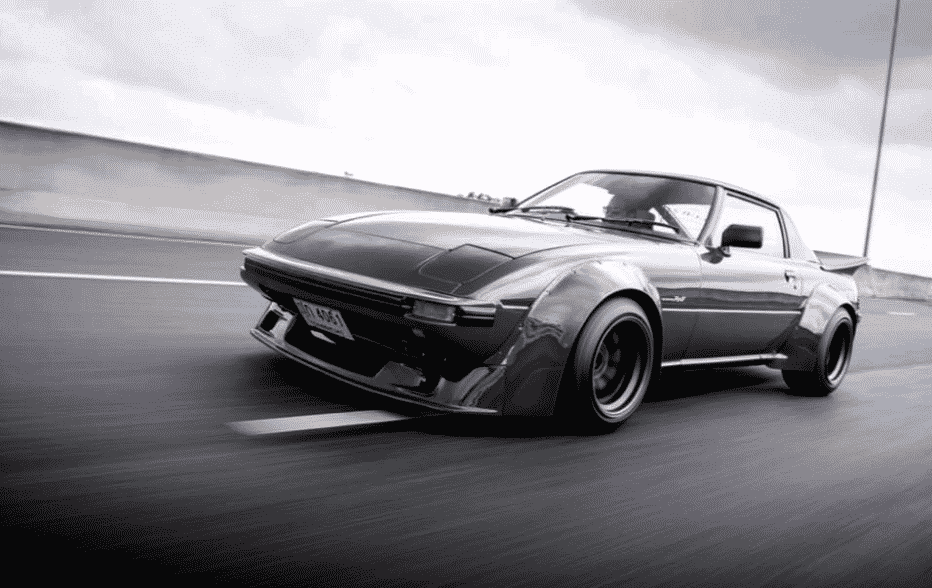
The first-generation RX-7 was introduced in March of 1978 with the intention of replacing the outdated Savana RX-7. It was designed to be a fun, economical sports car and was one of only two Wankel-powered cars in Mazda’s arsenal. Since the rotary engines produced fairly high horsepower from a relatively small displacement motor, the RX-7 became very popular with the Japanese consumer due to the fact that Japan had very strict taxes for cars with motors over 1.5L.
RX-7s were offered with three engine choices. Two 1.1L, one of which was turbocharged, and one 1.3L naturally aspirated engine. Additionally, clients had the choice of four transmission options. They could choose between a four and a five-speed manual and a three and four-speed automatic.
As the FB went on, slight modifications were made to improve the handling, appearance, and even safety of the car. The 1981-1983 car got lighter and received four-wheel disc brakes alongside some interior improvements.
1985-1992 Mazda RX-7 (FC) Second Generation
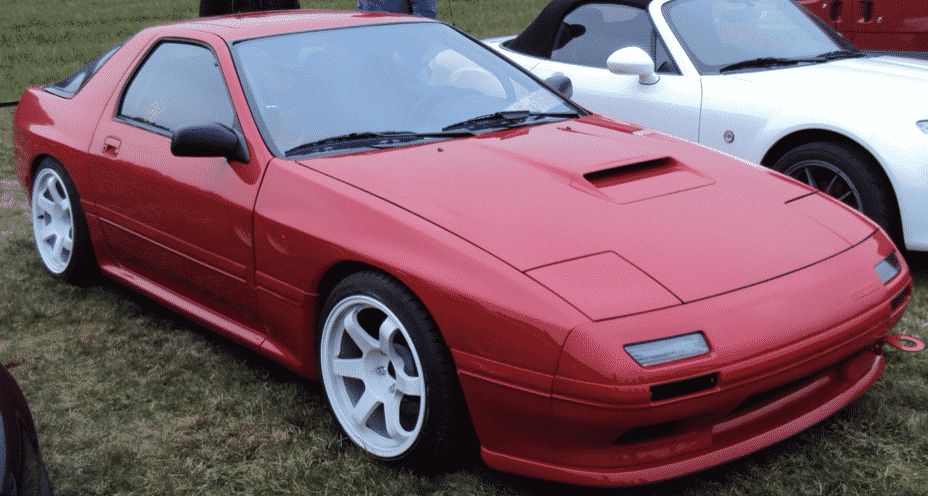
Mazda introduced the FC in 1985 with quite a few improvements, both mechanically and cosmetically. In the looks department, the RX-7 looked a lot more streamlined and aggressive. They even offered a convertible version of the RX-7. Additionally, Mazda ditched the outdated carbureted engines and introduced state-of-the-art fuel injection to their cars.
For this generation, the automaker kept it rather simple when it came to engine choices. All of them were the now-iconic 1.3L motors. There was a total of four variations of the 13B engine. Two were naturally aspirated, while the remaining two were the more powerful turbocharged versions. A five-speed manual and four-speed automatic transmission were the only two choices available.
In 1988 Mazda launched the 10th-anniversary edition RX-7. This consisted of an all-white exterior with colour-matching wheels, moulding, tail light housings, and mirrors. The GTU trim was sold between 1989-1990, and it was more geared towards performance. It started off as the basic car with no sunroof, A/C, and other goodies that would add weight. Mazda then added four-piston brakes, 16” wheels, special cloth seats, one-piece brakes, etc. to make it a track-ready car from the factory.
1992-2002 Mazda RX-7 (FD) Third Generation
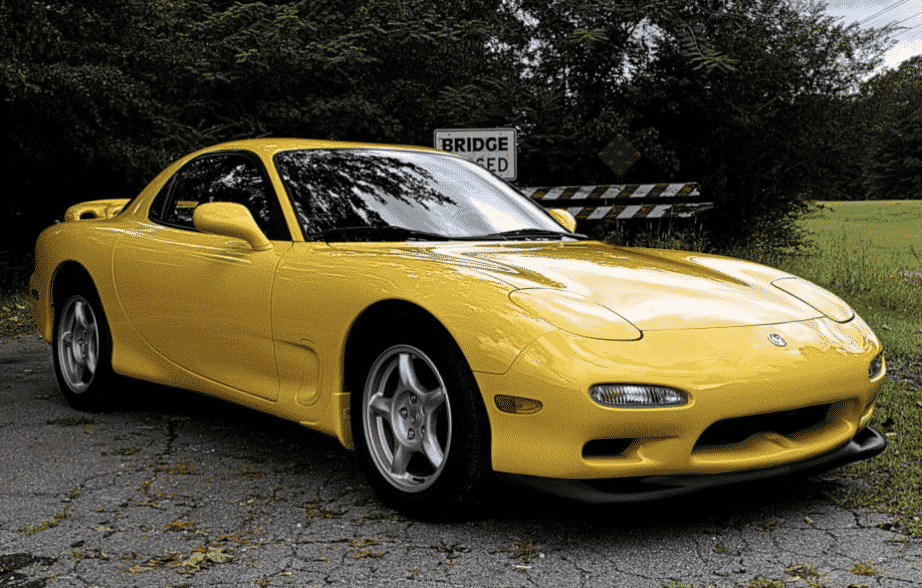
Believe it or not, the last generation RX-7 was in production for a total of 10 years. By this time, the RX-7 was a unique sports car that everyone wanted to get their hands on. The best part is that the FC came with the same 1.3L engine, but for this generation, it was twin-turbocharged and produced roughly 250 horsepower and 217 lb. ft. of torque.
The downside was that the price was considerably higher than other comparable models on the market, which turned many people away at the time. In fact, Mazda only managed to sell 1,152 examples of the FD RX-7 in all of Europe.
As the years progressed, changes were made to increase the reliability of the FD. Most of those changes were unseen and came in the form of mechanical and suspension upgrades. The body more or less stayed the same.
A high-end “RS” version of the RX-7 was unveiled. It came with slightly more power (276hp), standard 17” wheels, and was overall lighter compared to a stock model. The “Type R” was even lighter than the “RS” and included a stunning red interior alongside different wheels. Lastly, the “Spirit-R” took all the best features from previous FDs and combined them to produce this car in a limited number of only 1,500.
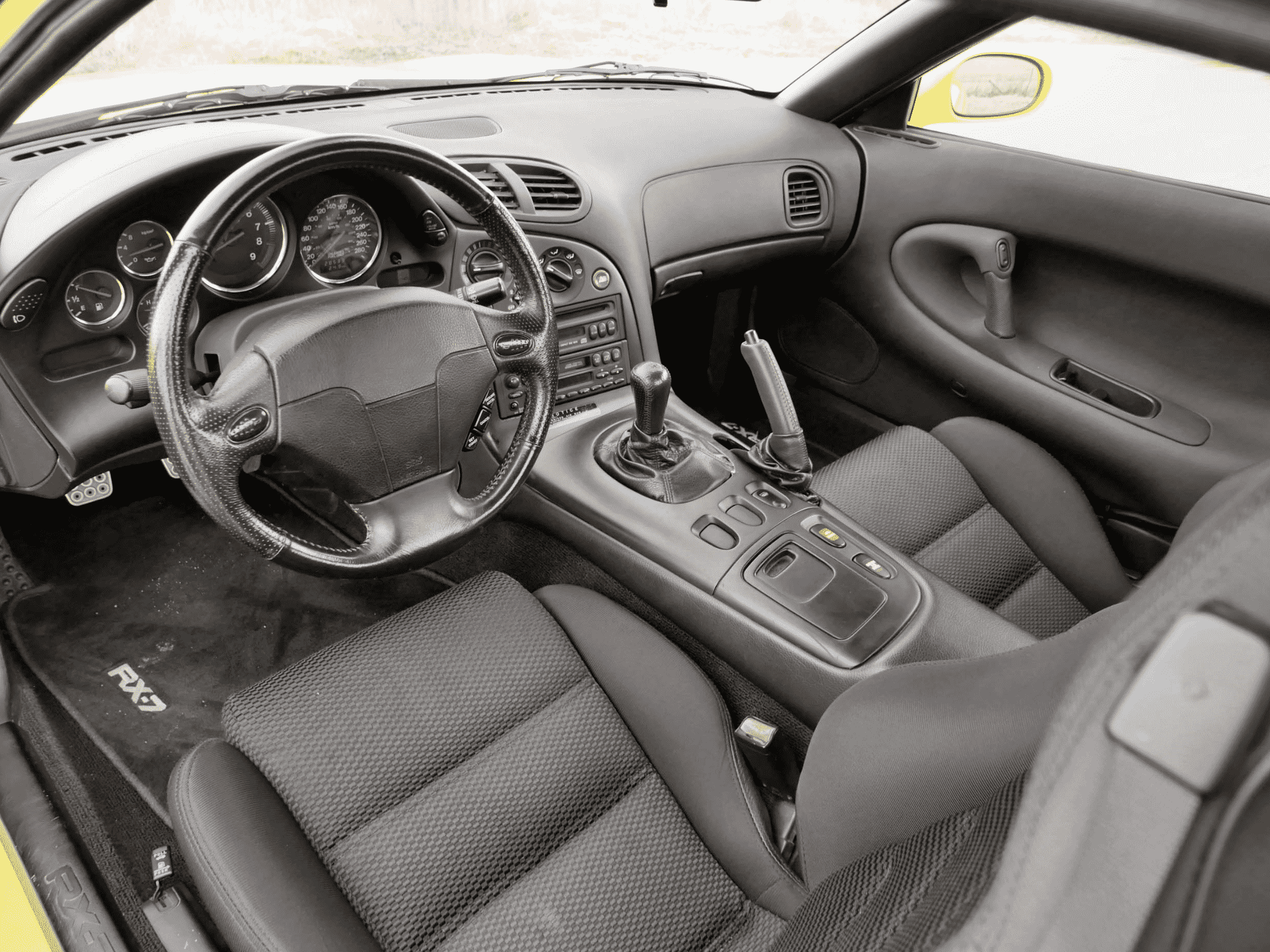
FAQ
Mazda Produced its flagship sports car, the Mazda RX-7, from 1978 to 2002. The RX-7 was produced in Japan for 3 generations and is famous mainly because of its rotor engine.
Early production models of the Mazda RX-7 are the cheapest as they start at around $19,000, which might increase or decrease depending on the car’s spec, mileage, and condition. The third-gen RX-7 (FD3S) is the most expensive as you’ll rarely find one being sold for under $30,000, and prices can go over $70,000.
After 1995, the Mazda RX-7 was produced as a left-hand-drive car only for the Japanese market, making it illegal for import in the United States. However, suppose you are looking to buy an RX-7. In that case, you can buy one that was locally imported from a seller outside the United States and registered in the United States.
The Mazda RX-7 has a top speed of 161mph on the odometer. It has 0-60mph times of 6.3 seconds
RX-7s are common in the United States, and if you walk into any JDM auto seller, you’ll not lack one that is put up for sale. Individual sellers also list their cars online, and you can also find other RX-7 listings online. View Our Mazda RX-7 Ads for Sale.
Mazda announced the discontinuation of the RX-7 in 2002, although the car was still produced for several more years. The last RX-7 rolled off the assembly line in 2008. The decision to discontinue the vehicle was mainly due to declining sales. In 1992, Mazda sold nearly 40,000 RX-7s in the United States in its peak year. However, by 2002, that number had fallen to just over 2,500. In addition, safety and emissions regulations were becoming increasingly strict, making it difficult for Mazda to continue producing the car without making significant changes.
The Mazda RX-7 has gotten expensive due to several factors, including limited production and the car’s increasing rarity, making it a collector’s item. However, for collectors and fans of the RX-7, the high price is well worth it for the chance to own a piece of automotive history.
A total of 811,634 RX7s were built during the production span, making it one of the best-selling sports cars. The vast majority of RX7s were sold in the United States, with over 400,000 units finding homes in the United States.
The Mazda RX-7 was produced in Mazda’s Hiroshima facility in Hofu, Yamaguchi, Japan. All generations were made in Japan, and no units were produced outside Japan.
Most insurance agencies will ask for around $900 annually to cover your RX-7, but this is not usually a fixed price. Some factors contributing to an increase or decrease in insurance payments are the owner’s home location and the car’s worth, especially if it’s a rare spec.
Most Mazda RX-7 owners treasure their cars, so buying one shouldn’t be difficult. Once you verify the necessary paperwork, check for rust and paint condition, and test drive the vehicle to assess the engine, suspension, and drivetrain condition.
This depends on the generation and year of production. The first-gen RX7 (SA) is between 37 and 44 years old, the second-gen (FC) is between 30-45 years old, and the third-gen (FD) is between 25 and 30 years old
Sources
- https://en.wikipedia.org/wiki/Wankel_engine
- https://en.wikipedia.org/wiki/Mazda_RX-7
- https://www.drifted.com/mazda-rx7/
- https://www.breakeryard.com/car-parts/mazda/rx7/common-problems
- https://www.rx7club.com/new-member-rx-7-technical-256/common-problems-come-owning-rotary-986744/
- https://www.hagerty.com/media/buying-and-selling/fd-mazda-rx-7-buyers-guide/
- http://www.superstreetonline.com/features/1706-jdm-supercar-alternatives-this-not-that/
- http://www.speedhunters.com/2018/10/taking-the-time-to-build-an-rx-7-the-right-way/
How to Import a Mazda RX-7
Read our ultimate guide, How to Import a Car from Japan.
Can you make this guide better? Are you a huge fan of the RX-7? If so, please contact us.
